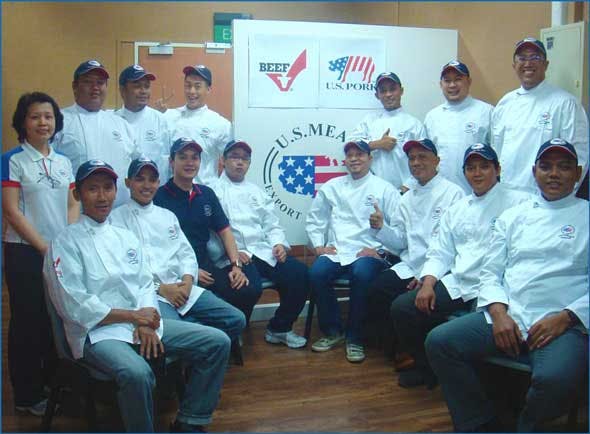USMEF Puts 14 Indonesian Chefs Through Intensive 2-Day Training
Published: Jun 20, 2011
A group of 14 leading chefs from Jakarta and other parts of Indonesia recently was given an intensive two-day training program on U.S. beef and pork products as well as efficient restaurant operation through the USMEF Singapore Culinary Training Program with funding provided by the Beef Checkoff, Pork Checkoff and USDA Market Access Program (MAP).

The chefs were drawn from the winners of USMEF cooking challenges and included individuals recommended by one of Indonesia’s top meat importers.
“The growth in Southeast Asia’s largest economy, Indonesia, has attracted a legion of investors and entrepreneurs eager to capitalize on the country’s strong growth,” said Sabrina Yin, USMEF-ASEAN director. “The Indonesian food and beverage, retail and hotel industries are rising on the success of the economy and a growing middle class, so our aim is to increase our presence in these sectors and help top chefs to further understand and better market our products.”
The two-day session started with cutting and cooking demonstrations involving U.S. beef top blade muscles, rib fingers, short plate, chuck tenders, shoulder tenders and hanging tenders.
The menu included chuck tender carpaccio, rib finger curry, short plate roast and grilled shoulder tender. The participants also had the opportunity to experience the unique flavor and taste of dry-aged striploin.
The first day of the session also covered the importance of foodservice sanitation before the group conducted retail and restaurant visits to view different restaurant concepts and menu trends in Singapore.
The second day of the program was devoted to U.S. pork. While several of the chefs do not eat pork for religious reasons, they were enthusiastic to learn about new U.S. pork products as business and tourism visits to the country are growing. Cooking and cutting demonstrations were done on boneless pork loin and boneless pork butt, and a number of processed pork items were sampled, including pre-cooked bacon and assorted gourmet sausages.
A discussion session was held on ASEAN food trends before the group participated in two foodservice management modules, “How to Conduct an Effective Menu Promotion” and “Menu Layout & Design.” The group also enjoyed a brief presentation from the U.S. Potato Board.
“The feedback from the participants was outstanding,” said Yin. “Everyone said they learned a great deal about U.S. beef and pork.”
It is not uncommon for Indonesian chefs to purchase their meat by asking the importer what cuts are suitable for his or her restaurant’s dishes. “Now, equipped with the knowledge of the different U.S. meat cuts available in this market, I can confidently order the specific type of cuts I need for my restaurant,” said Andy Winata of the Butcher Restaurant.
“The growth in Southeast Asia’s largest economy, Indonesia, has attracted a legion of investors and entrepreneurs eager to capitalize on the country’s strong growth,” said Sabrina Yin, USMEF-ASEAN director. “The Indonesian food and beverage, retail and hotel industries are rising on the success of the economy and a growing middle class, so our aim is to increase our presence in these sectors and help top chefs to further understand and better market our products.”
The two-day session started with cutting and cooking demonstrations involving U.S. beef top blade muscles, rib fingers, short plate, chuck tenders, shoulder tenders and hanging tenders.
The menu included chuck tender carpaccio, rib finger curry, short plate roast and grilled shoulder tender. The participants also had the opportunity to experience the unique flavor and taste of dry-aged striploin.
The first day of the session also covered the importance of foodservice sanitation before the group conducted retail and restaurant visits to view different restaurant concepts and menu trends in Singapore.
The second day of the program was devoted to U.S. pork. While several of the chefs do not eat pork for religious reasons, they were enthusiastic to learn about new U.S. pork products as business and tourism visits to the country are growing. Cooking and cutting demonstrations were done on boneless pork loin and boneless pork butt, and a number of processed pork items were sampled, including pre-cooked bacon and assorted gourmet sausages.
A discussion session was held on ASEAN food trends before the group participated in two foodservice management modules, “How to Conduct an Effective Menu Promotion” and “Menu Layout & Design.” The group also enjoyed a brief presentation from the U.S. Potato Board.
“The feedback from the participants was outstanding,” said Yin. “Everyone said they learned a great deal about U.S. beef and pork.”
It is not uncommon for Indonesian chefs to purchase their meat by asking the importer what cuts are suitable for his or her restaurant’s dishes. “Now, equipped with the knowledge of the different U.S. meat cuts available in this market, I can confidently order the specific type of cuts I need for my restaurant,” said Andy Winata of the Butcher Restaurant.
